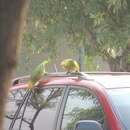Biology
provided by Arkive
This is a social parrot that lives in flocks of up to several hundred individuals (5). During the breeding season from February to June (2) it lives in monogamous pairs and nests in hollow tree cavities (5) (6). Two to three eggs are typically laid per clutch, incubated by the female for 26 to 28 days (5) (6), but nesting success is only 0.5 fledglings per nest (2). As with many parrots, the male will feed the female through regurgitation while she incubates the eggs and feeds the young. Young leave the nest at 8 to 12 weeks of age, and sexual maturity is attained within three to four years (5).
Yellow-headed parrots feed on fruit, nuts, berries, blossoms and leaf buds, and are also known to raid cultivated crops such as maize (2) (3).
Conservation
provided by Arkive
The yellow-headed parrot is listed on CITES Appendix I, prohibiting international trade in wild-caught specimens (3). Captive-breeding is fortunately now supplying much of the demand and most of the recent international trade has involved captive-bred birds, although trapping continues to supply domestic markets and birds for illegal export. Trade is banned in Honduras and trapping and trade are banned in Belize (7). This parrot receives some protection in El Cielo Biosphere Reserve, Sanoval Ranch in Mexico, and in seven protected areas in Belize, and there are several country-wide awareness campaigns in Mexico (2). However, without further efforts to conserve habitat and control illegal domestic and international trade, particularly in Mexico, the yellow-headed parrot's future does not look bright (7).
Description
provided by Arkive
The most distinctive features of this primarily green parrot are its yellow head and the red patch, or speculum, on each wing, which are lacking in young birds but become more prominent with age (3). There are also dark blue tips to the flight feathers and yellow tips to the tail, with red marks on the base of the outer tail feathers (2). The stout, hooked beak is used for cracking nuts and seeds as well as for grasping and climbing, and the feet are also highly adapted for grasping, having two toes pointing forward and two pointing backward (3).
Habitat
provided by Arkive
Preferred habitats include tropical and subtropical forests, mangrove swamps, savannah, coastal scrub and cultivated land where trees are available for nesting (2) (3).
Range
provided by Arkive
Mexico is the primary range state with additional, small populations occurring from northeastern Guatemala to the Honduras border, and in Belize (4).
Status
provided by Arkive
Classified as Endangered (EN) on the IUCN Red List 2006 (1) and listed on Appendix I of CITES (3).
Threats
provided by Arkive
The primary threats facing the yellow-headed parrot are habitat destruction and over-collection for the pet trade (4). Many thousands have been illegally exported from Mexico and some from Belize each year, and this bird is popular in domestic markets (2). Moreover, it has been estimated that up to 90% of smuggled parrots die before reaching foreign markets (4). In Belize, this bird is also hunted and persecuted for being a crop pest (2). Deforestation has been extensive, with large areas cleared for agriculture, pasture, lumbar and settlements, resulting in the loss of nesting and foraging habitat (2) (5). Nest poaching exacerbates habitat loss, since nesting trees are often felled to get at nestlings, destroying critical nest sites in the process (4).

